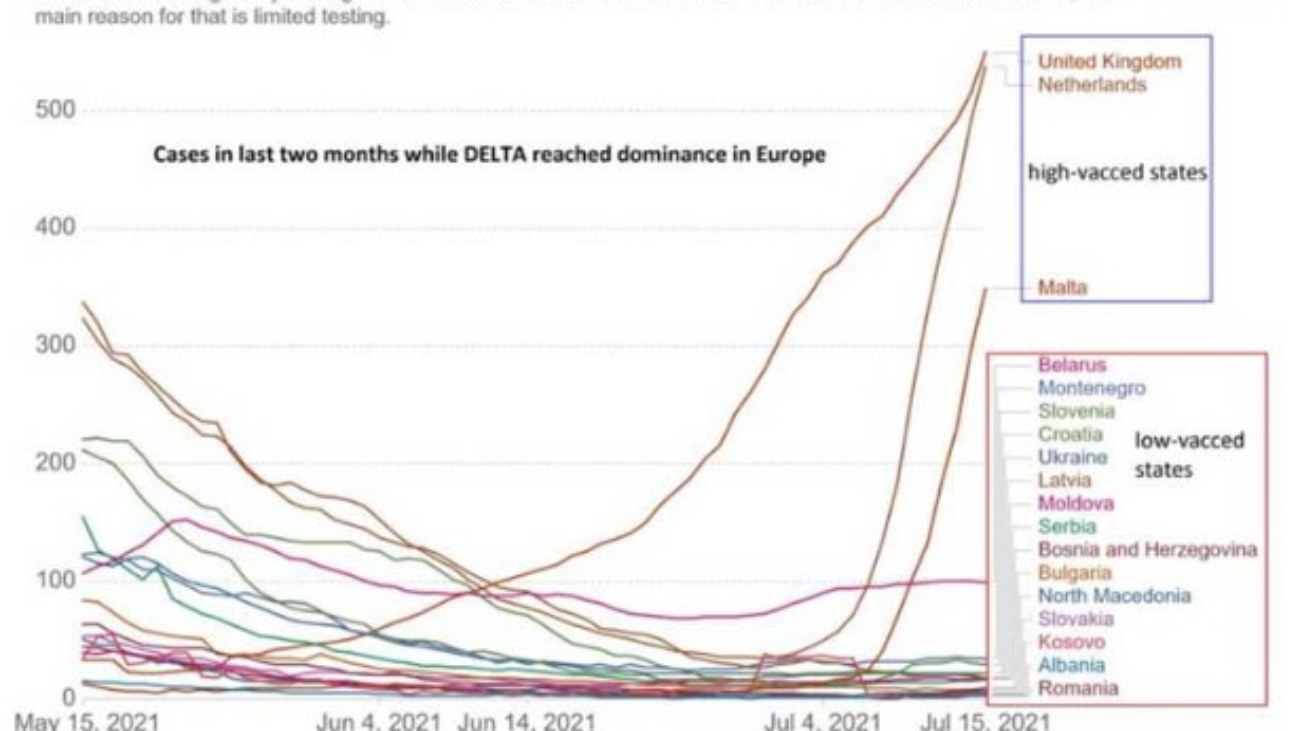Please take this research out of the UK into consideration as additional rounds of vaccine (gene therapy) are offered.
STORY AT-A-GLANCE
- In the U.K., symptomatic COVID-19 cases among “vaccinated” individuals have risen 40% in one week, reaching an average rate of 15,537 new infections a day being detected. Meanwhile, symptomatic COVID-19 cases among the unvaccinated has declined by 22% and is now at a current daily average of 17,588
- This suggests the wave among unvaccinated has peaked and that natural herd immunity has set in, while “vaccinated” individuals are actually becoming more prone to infection
- Data show countries with the highest COVID injection rates are also experiencing the greatest upsurges in cases, while countries with the lowest injection rates have the lowest caseloads
- 100 fully injected crew members had tested positive onboard the British Defense aircraft carrier HMS Queen Elizabeth. The Navy ship has a case rate of 1 in 16 — the highest case rate recorded. This suggests vaccine-induced herd immunity is impossible, as these injections apparently cannot prevent COVID-19 even if 100% of a given population gets them
- It is mathematically impossible for COVID shots to eliminate SARS-CoV-2 infection. The four available COVID shots in the U.S. provide an absolute risk reduction between just 0.7% and 1.3%. Meanwhile, the noninstitutionalized infection fatality ratio across age groups is a mere 0.26%. Since the absolute risk that needs to be overcome is lower than the absolute risk reduction these injections can provide, mass vaccination simply cannot have a favorable impact
Full article here:
Delta Variant: Natural Immunity 700% Better Than the Vaccine
STORY AT-A-GLANCE
- Data presented to the Israeli Health Ministry July 17, 2021, revealed that, of the more than 7,700 COVID-19 cases reported since May 2021, only 72 occurred in people who had previously had COVID-19 — a rate of less than 1%
- In contrast, more than 3,000 cases — or approximately 40% — occurred in people who had received a COVID-19 vaccine
- In other words, those who were vaccinated were nearly 700% more likely to develop COVID-19 than those who had natural immunity from a prior infection — and this is largely in response to the Delta variant, which has led to increasing infections in Israel
- It’s extremely rare to get reinfected by COVID-19 after you’ve already had the disease and recovered; one study found the median reinfection rate was just 0.27%
- With effective treatments available, the documented high survival rate of COVID-19 and knowledge that if you’ve had COVID-19, you’re already likely immune to further infection, the rationale for getting vaccinated is faltering
Full article here:


Statistics stated are not valid. Should say, “0f those contracting COVID in England, 3000 (40% of the 7,700) were vaccinated.”
This does NOT indicate vaccinated individuals are 40% more likely to contract the virus. The base of the percentage must be the vaccinated population compared to the unvaccinated population.
U.S. stats indicated that of those contracting COVID, less than 1% were vaccinated. Not sure why U.K. Stats and U.S. Stats are so different.
Hi Robin. Sorry for the delayed response but thank you for your comment! I do believe you have pointed out an error in the math but I think there was also a typo in your comment. Did you mean to say “This does NOT indicate vaccinated individuals are 700% more likely to contract the virus?” The abstract says 700%, not 40%.
When I did the odds likelihood ratios for myself I found that in this group of ~7,700 covid cases, the vaccinated individuals were 75.6x (7,555%) more likely to have contracted covid compared to the unvaccinated individuals.
Odds Likelihood Radio Vaccinated: 3000/4400 = 0.68
Odds Likelihood Radio Unvaccinated: 72/7628 = 0.009 (7628 is the number of individuals that did not contract covid a second time (7700-72 = 7628) in the unvaccinated group)
Odds Likelihood Radio Vaccinated vs Unvaccinated: 0.68/0.009 = 75.6x (7,555%)
Here’s instructions on calculating the Odds Likelihood Radio
https://towardsdatascience.com/how-to-interpret-and-calculate-x-times-more-likely-statistics-daf538a9e0f4
Please let me know if you have any other comments/questions. Thanks for checking the math with me!